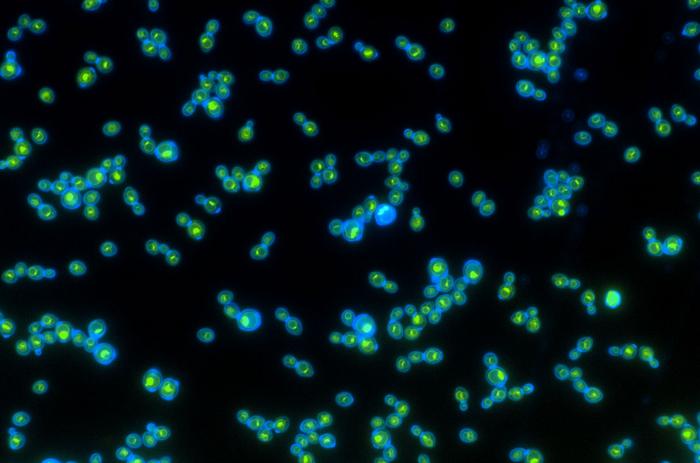Shining a Light on Yeast: A Breakthrough in Biological Engineering
In a striking evolutionary twist, researchers create a yeast strain that thrives in light, potentially revolutionizing biofuel production and aging studies
Jan 15, 2024
AI Image Created Using DALL-E
In the culinary realm, yeast is a humble yet mighty organism, content in its role as the alchemical catalyst that transforms mundane carbohydrates into the delights of bread and beer, thriving in the shadowy, fermenting depths. But what if this age-old process was upended by a twist that could redefine our understanding of this microscopic powerhouse? This is precisely what researchers at Georgia Tech’s School of Biological Sciences have set their sights on as they unveil a groundbreaking discovery: a strain of yeast that not only tolerates but thrives in the light.

Imagine a world where yeast, the cornerstone of so many of our culinary and brewing traditions, could be coaxed into a new form of existence, one where light, not darkness, becomes its ally. This is not a fanciful thought experiment but a reality brought forth by Anthony Burnetti and his team. Their research, published in Current Biology, is akin to a biological revelation. “We were frankly shocked by how simple it was to turn the yeast into phototrophs,” Burnetti, a research scientist in Associate Professor William Ratcliff’s laboratory, admits with a sense of awe. “All we needed to do was move a single gene, and they grew 2% faster in the light than in the dark. Without any fine-tuning or careful coaxing, it just worked.”
This feat is not just a scientific curiosity. It has profound implications for our understanding of evolution, biofuel production, and even the mysteries of cellular aging. It's a testament to the power of simple genetic tweaks to usher in complex biological changes.
The seeds of this discovery were sown in the group’s earlier explorations into multicellular life's origins. Their earlier work, encapsulated in Nature, delved into how their model organism, “snowflake yeast,” evolved multicellularity over thousands of generations. But a stumbling block emerged: energy constraints within multicellular structures. “Oxygen has a hard time diffusing deep into tissues, and you get tissues without the ability to get energy as a result,” explains Burnetti. The solution? Light.
The evolutionary puzzle of harnessing light for energy is intricate, often involving a complex array of genes and proteins. This complexity has stymied attempts to replicate the process in other organisms, both in nature and the lab. But nature often favors simplicity, and the Georgia Tech team found their answer in rhodopsins. These proteins, widespread across the Tree of Life, offer a more straightforward method of converting light into energy. “Rhodopsins are found all over the tree of life and apparently are acquired by organisms obtaining genes from each other over evolutionary time,” notes Autumn Peterson, a biology PhD., student and lead author of the study.
Their approach hinged on the phenomenon of horizontal gene transfer, a process where genetic material is exchanged between different species, leading to rapid evolutionary leaps. This process is particularly prevalent with rhodopsins. “In the process of figuring out a way to get rhodopsins into multi-celled yeast,” Burnetti explains, “we found we could learn about the horizontal transfer of rhodopsins that has occurred across evolution in the past by transferring it into regular, single-celled yeast where it has never been before.”
The team's success was marked by the introduction of a rhodopsin gene from a parasitic fungus into common baker’s yeast. This gene was tailored for vacuolar rhodopsin, enabling the yeast to turn light into energy efficiently. The result was a yeast that grew about 2% faster in light than in darkness—a significant evolutionary advantage.
“This simplicity provides key evolutionary insights and says a lot about the ease with which rhodopsins have been able to spread across so many lineages and why that may be so,” Peterson adds, highlighting the broader implications of their findings.
The potential applications of this discovery are vast. From exploring ways to mitigate cellular aging to advancing biofuel production, the doors opened by this research are as numerous as they are promising. As for Ratcliff’s team, their sights are set on the broader evolutionary journey. They're particularly intrigued by how this newfound phototrophic ability in yeast could influence its transition from a single-celled organism to a multicellular one. “We have this beautiful model system of simple multicellularity,” Burnetti says, referring to the Multicellularity Long-Term Evolution Experiment (MuLTEE). “We want to give it phototrophy and see how it changes its evolution.”
This study is not just about yeast or light; it's a narrative about biological potential and the unexpected pathways of evolution. It's about finding simplicity in complexity and the profound implications of a single genetic tweak. In the grand scheme of life's tapestry, the Georgia Tech team has added a vibrant new thread, demonstrating how a small change can illuminate the path to understanding life's intricate web.


















